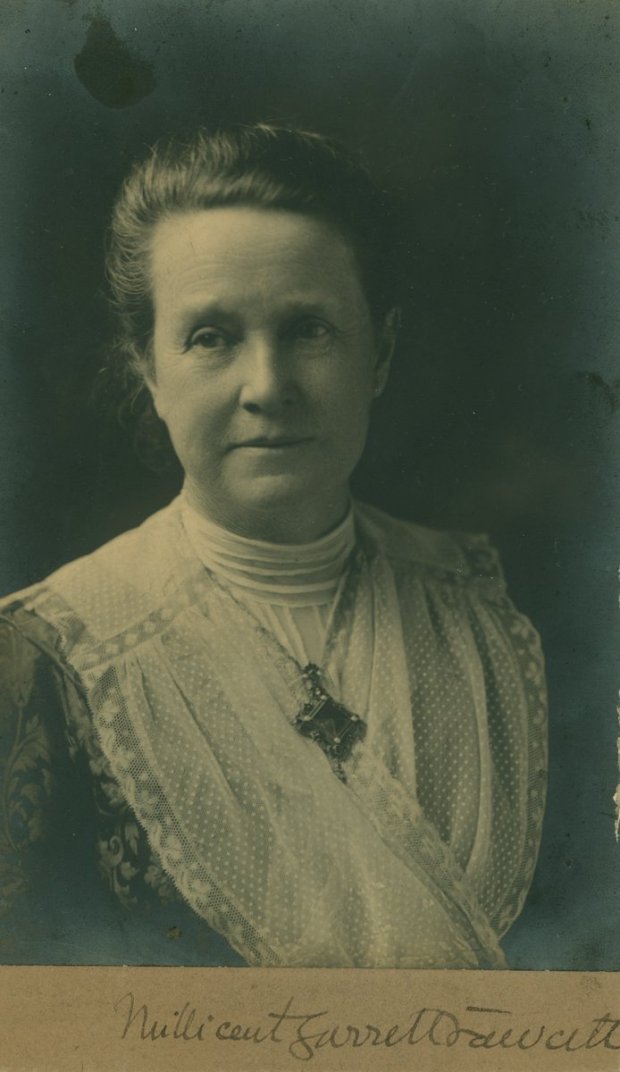Millicent Fawcett wearing a pendant given to her by the NUWSS in recognition of her service
Because of copyright issues, I don’t feel able to show you the portrait of Mrs Pankhurst that hangs in the National Portrait Gallery. But I wonder how many of you know without looking here which one I mean?
As I thought, a great many. That is doubtless because the portrait is on permanent display.
Mrs Pankhurst’s presence is also kept before us in the shape of her statue in Victoria Tower Gardens, right next to the House of Commons.Both of these images are not where they are by chance. Immediately after her death former suffragettes determined to memorialise their leader in this time-honoured tradition – a portrait painted for the national collection and a statue erected in a prominent and relevant position.
Therefore, it’s unsurprising that Mrs Pankhurst is remembered.
But what of Mrs Millicent Fawcett, whose method of campaigning for the vote for women differed from that of Mrs Pankhurst, but who was in many ways the more effective politician. Indeed, it was she who finally delivered ‘votes for women’.
Mrs Fawcett has no statue. The National Portrait Gallery’s only painted portrait of Mrs Fawcett is this one by Ford Maddox Brown that depicts her as the tender young wife of Henry Fawcett, the blind politician. Incidentally this painting hangs, not in London, but in Bodelwydden Castle. UPDATE: the portrait was moved back to the main London gallery in 2018.
Tate Britain does hold this portrait of Millicent Fawcett, painted at the end of her life by her friend Annie Swynnerton. Mrs Fawcett is shown wearing academic dress, her honorary degree robes from St Andrews.
This painting is permanently in storage. It was shown at the Royal Academy in 1930 and, after being bought for the nation as a Chantrey Bequest purchase, has never been seen in public since. When I was writing Enterprising Women I arranged to see the painting in the Tate’s store. There was no difficulty – beyond making an appointment – in gaining access – but how very different from saying ‘hallo’ to Mrs Pankhurst every day, if one so chose, in the National Portrait Gallery.
Why can’t this portrait be brought out of storage and, if it doesn’t fit into the Tate Britain hanging policy, be transferred to the National Portrait Gallery where it would admirably complement Mrs Pankhurst?
Mrs Fawcett was not, of course, without staunch memorialising supporters. But, rather than a statue, they put their efforts into a building – Women’s Service House in Marsham Street, Westminster – and named the large hall inside for Mrs Fawcett. Financial exigency has long since separated the building from the women’s movement (although we are thankful that it has been given a new lease of life by Westminster School). For many years Millicent Fawcett’s name was synonymous with the wonderful library that originated in Women’s Service House but was at the beginning of the 21st century given the much less resonant name of The Women’s Library.
However Mrs Fawcett’s lifelong work for the women’s cause is still commemorated in the vigorous efforts of The Fawcett Society. I am sure, sensible woman that she was, she would much rather that that was the case than that her portrait should hang in the National Portrait Gallery. And, yet, knowing how responsive the public is to the visual image, I do wish she might be allowed to share Mrs Pankhurst’s limelight.
Because it would be too ironic to devote a post to bemoaning the lack of visual representation of Mrs Fawcett, here she is, wearing an National Union of Women’s Suffrage Societies badge.
Read much more about Millicent Fawcett – and all the Garretts – in Enterprising Women: the Garretts and their circle
and when in London visit the Elizabeth Garrett Anderson Gallery.
UPDATE: And if there were to be a statue of a woman in Parliament Square (see here) to commemorate the women’s suffrage campaign, why should it not be of Millicent Fawcett?
MUCH LATER UPDATE: And there is now, of course, a remarkable statue of Millicent Fawcett now standing in Parliament Square, unveiled in 2018. So she is definitely becoming more visible.



#1 by marytalbot2012 on July 18, 2013 - 11:34 am
Excellent post, as ever! As you say, better to be remembered through the Fawcett Society and its work than any number of bronze and paint effigies. I wonder if my Sally Heathcote story will dislodge Mrs Pankhurst from her pedestal at all?
#2 by Chloe Mason on October 30, 2013 - 7:37 am
Both Emmeline and Millicent were duplicitous at a significant moment in herstory. Perhaps it’s overdue to celebrate Catherine Marshall Isabella Ford Sylvia etc etc etc
Best wishes
Chloe Mason
#3 by womanandhersphere on October 30, 2013 - 9:20 am
And, as a bookseller, I can sell you biographies of all three of the women you mention - as well as biographies of many other workers for the Cause. Do email me a list of any for which you are looking. In addition you can, of course, read c 400 biographies of suffragists and suffragettes in my Women's Suffrage Movement: a reference guide.
Best wishes
Elizaabeth